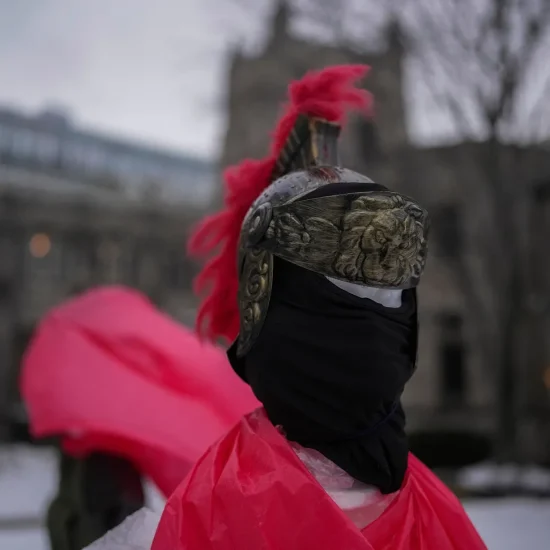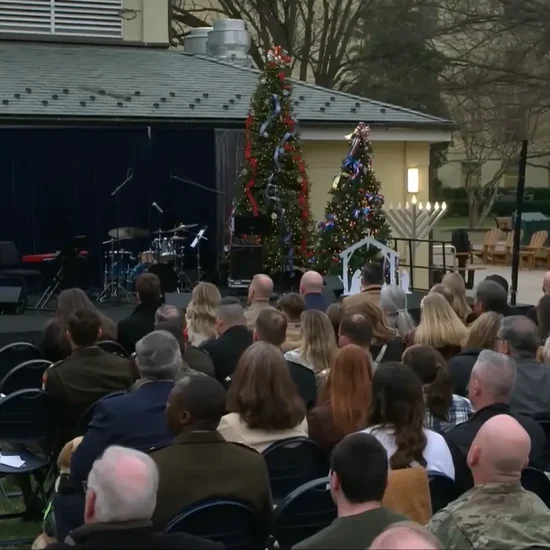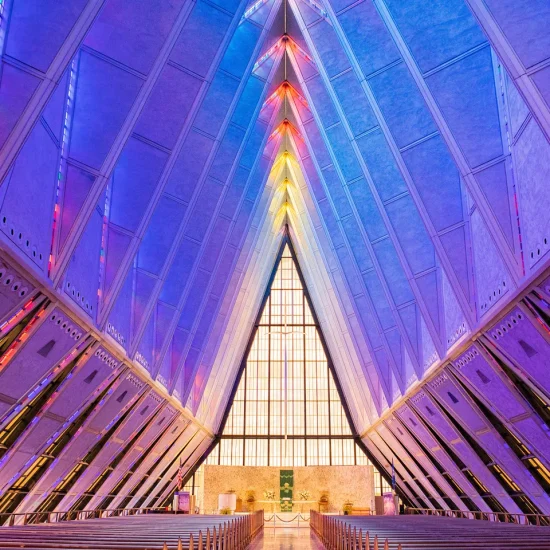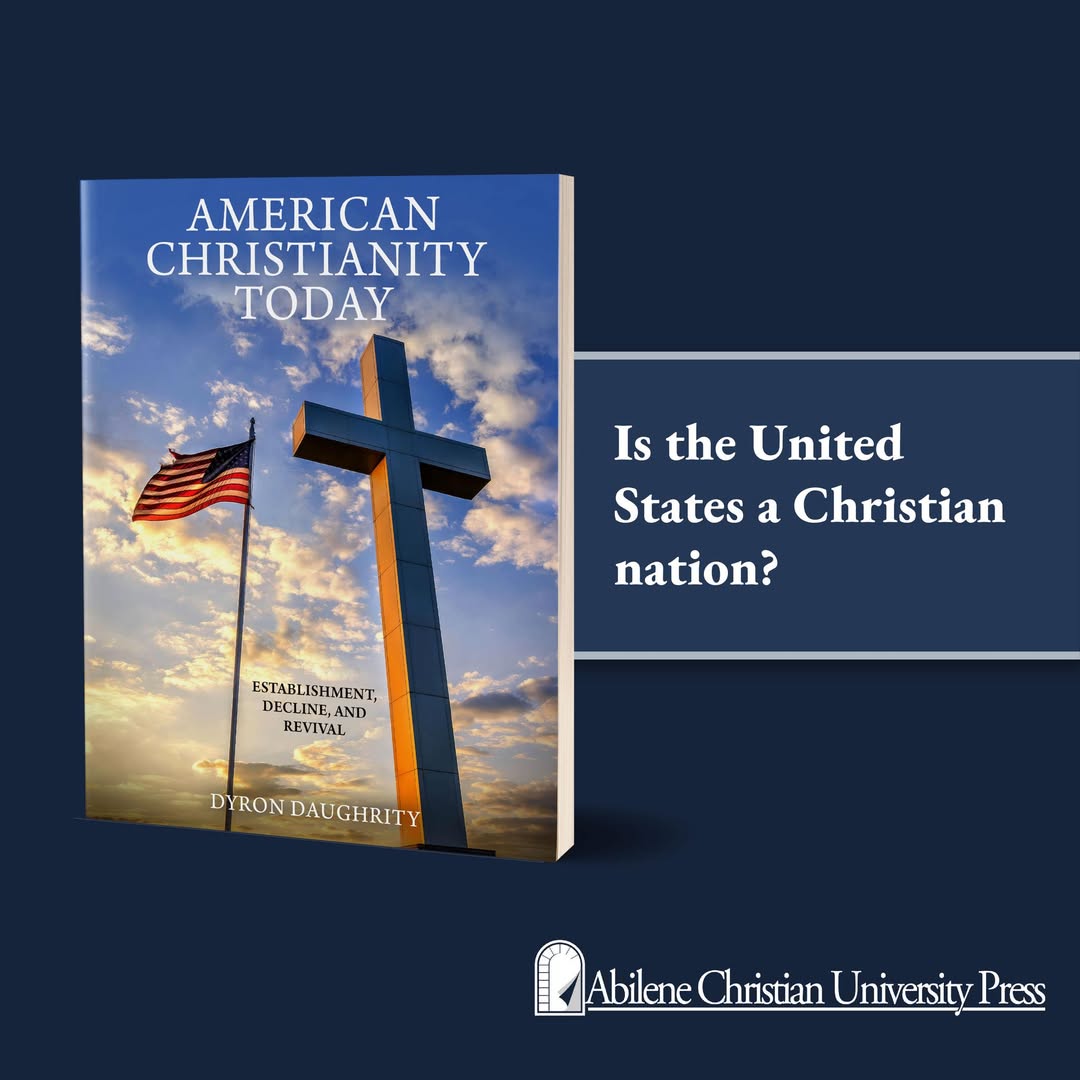
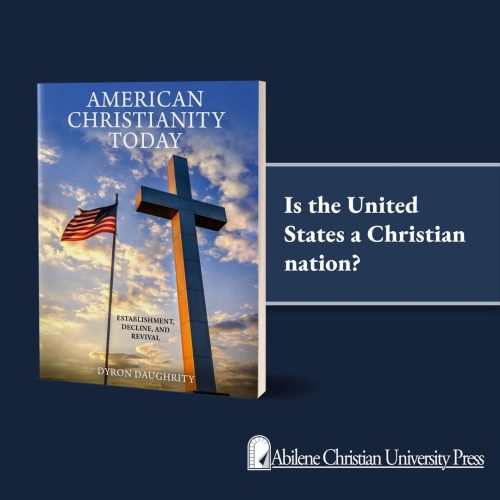
AMERICAN CHRISTIANITY TODAY: Establishment, Decline, and Revival. By Dyron Daughrity. Abilene, TX: Abilene Christian University Press, 2024. 304 pages.
The debate rages, especially in light of the ascendancy of a virulent form of Christian Nationalism, about whether the United States is a Christian nation. The answer to that question depends on how we define our terms. Constitutionally, the United States is a secular nation in which no officeholder is required to affirm any religious/faith position. Article 6 of the Constitution is quite clear: “No religious test can be required for any office or public trust under the United States.” This is the only mention of religion in the Constitution itself. The First Amendment, which seems less important to many than the Second Amendment, states: “Congress shall make no law respecting an establishment of religion, or prohibiting the free exercise thereof; …” The Declaration of Independence does mention the Creator and Divine Providence, but neither of these terms is inherently Christian. Interestingly, the Constitution of the Confederate States of America, a “nation” formed in part to defend slavery, does invoke “Almighty God” in defining its existence. Finally, the Treaty of Tripoli of 1797, signed under the Presidency of George Washington, let this Muslim nation know that “As the government of the United States of America is not in any sense founded on the Christian Religion, as it has in itself no character of enmity against the laws, religious or tranquility of Musselmen, and as the said States never have entered into any war or act of hostility against any Mehomitan nation, it is declared by the parties that no pretext arising from religious opinions shall ever produce an interruption of the harmony existing between the two countries.” Speaking in legal terms, the United States is not a Christian nation.

Robert D. Cornwall
America is, instead, a secular country and has been so from the beginning of this constitutional republic. Although this is true, legally, it is also true that the nation that emerged from the struggle for independence from the United Kingdom has been a majority Christian nation throughout its history. However, historically, and even today, the majority of citizens of the United States have claimed to be Christian, whether or not they were church members. So, perhaps in that sense, the United States is a Christian nation, but not a legal one.
Now that we have defined our terms and determined that legally speaking the United States of America is a secular nation and not a Christian one, we can move on to another topic. That topic concerns the status of Christianity in the United States today, recognizing that Christianity itself is very diverse. This is the question explored by Dyron B. Daughrity, the William S. Banowsky Chair and Professor of Religion at Pepperdine University, in his book American Christianity Today: Establishment, Decline, and Revival (ACU University Press, 2024). Daughrity approaches this question from a Churches of Christ perspective, which has its own set of unique elements. Church of Christ people tend to be on the conservative side but not necessarily evangelical. In this book, we see a conservative approach to religion emerge occasionally, but overall Daughrity offers a fair appraisal of American Christianity.
Before I get to the makeup of the book itself, that is, the content, I want to take note of the book itself. It is 8.5 by 11 inches, with double columns, printed on high-quality paper allowing for full-color pictures. It is designed to be used as a textbook for introductory classes on Christianity in the United States or just for perusing. The author provides pictures, sidebars, and a few graphs.
As we ponder the question about whether the United States is actually a Christian nation, Dyron Daughrity wants his readers to know that throughout the nation’s history, from colonial times to the present, the idea that the United States is a Christian nation has ebbed and flowed. We see this pattern revealed in the absence of religious language in the Constitution, while it is present in the Pledge of Allegiance, to which Congress added God in the 1950s when the United States wanted to contrast itself with the atheistic communists in the Soviet Union and China. As to whether we are currently witnessing the abandonment of Christianity at the current moment, or this is simply another expression of this ongoing ebbing and flowing only history can determine. With that question in mind, Daughrity invites us to consider the realities of the nation’s history that feature moments of decline and revival. The reality is, that Americans are just as “religious” today as ever, with the vast majority of Americans claiming to believe in God and even align with Christianity. So, what does this contemporary version of Christianity look like?
Daughrity divides his book, which is, as noted above, published on high-quality paper stock, with numerous color photos/images as well as numerous sidebars, into four parts. Part One, titled “Background and Orientation,” offers two chapters. The first chapter is titled “Christianity in the United States: Overviewing a Bewildering Religion.” In this opening chapter, Daughrity reminds us that when we speak of Christianity in the United States, we are talking about a very diverse religious reality. It is this diversity that seems to allow Christianity in America to thrive, even as we witness significant declines in Europe. He writes that “the decoupling of church and state in the United States has created a marketplace for Christian faith where people can pursue the kind of Christianity that best suits their needs” (p. 34). Now, that isn’t without its problems, but it is our reality.
The second chapter is titled “Red God, Blue God: American Christianity’s Close Connection to Politics.” This chapter sets out the other key point of the book. The United States might be a secular nation (legally), but religion and politics have been intertwined since the beginning of the nation. So, even though legally a secular nation, the United States has been very friendly to religion, such that “the currency, the national seal, the Pledge of Allegiance, the national anthem, the prayers that are said in Congress, the oaths sworn on the Bible in court and the ubiquitous phrase ‘In God We Trust’ all seem to point to a religious sensibility in the United States” (p. 37). As to whether this is always a good thing is a different question, as seen in the emergence of the so-called “Culture Wars.” Daughrity explores the various dimensions of this relationship, including the polarization that exists from time to time. He expects, rightly, I believe, that the pendulum will continue to swing from “red” to “blue,” and back with unity being achieved at times. At the same time, it seems that only an act of God can bring the nation back together. These two chapters, taken together, provide the foundation for what follows.
Part Two is titled “America’s Christian Traditions.” In eight chapters of about 8 to 10 pages each (double columns with pictures and sidebars), Daughrity briefly lays out the basic elements of the primary expressions of Christianity in the United States: Roman Catholicism (Chapter 3), Evangelicalism (Chapter 4), Mainline Protestantism (Chapter 5), the Black Churches (Chapter 6), Pentecostalism (Chapter 7), Eastern Orthodoxy (Chapter 8), Anabaptism, a chapter titled “Preachers of Peace” (Chapter 9), along with a chapter on three other traditions — Mormons, Jehovah’s Witnesses, and Seventh Day Adventists. That chapter, titled “Resilience and Proliferation,” explores, in brief, these three were born in the nineteenth century, along with several others that could be seen as more “orthodox” or traditional in their theology and practice, but while thriving, seek to adapt to the culture around them.
Having introduced the reader to the broad spectrum of a very diverse Christian population (and Christian options) laid out the spectrum of a diverse Christian population, in Part Three, Daughrity examines “Critical Issues in American Christianity.” Here he offers six chapters that address immigration (Chapter 11), Women and American Christianity (Chapter 12), Interreligious dialog (Chapter 13), Ecumenism (Chapter 14), Global Missions (Chapter 15), and a gathering “Hot Topics” that includes climate change, gender, abortion, sexuality, and race. As one might expect there are differences of viewpoint on these critical issues that reflect the diversity of American Christianity. He reminds us that politics often plays an important role in how religious communities face these issues.
The final section, Part Four, focuses on “Important Trends and Recent Movements in American Christianity.” Here, in the final eight chapters of the book, Daughrity gives attention to the following trends and movements: Christian entertainment (Chapter 17), Christian music (Chapter 18), Christian Youth Programs (I will note that these are all evangelical options) (chapter 19), Mega Churches (Chapter 20), Sacred Spaces — Church Buildings, monuments, and pilgrimage sites. In this chapter (Chapter 21), Daughrity provides a considerable number of pictures, including an image of one particular building per state. The remaining chapters focus on Urban Christianity (Chapter 22), Rural Christianity (Chapter 23), and Christian Higher Education.
In this well-laid-out and even encyclopedic book, filled with pictures and images, Daughrity provides us with an overview of what makes American Christianity, in all its diversity, tick. For the most part, Daughrity offers a fair appraisal of this diversity. However, his more evangelical moorings do come out at points, especially when dealing with trends and contemporary movements. Nevertheless, overall, Dyron Daughrity’s American Christianity Today was an enjoyable book to read. It demonstrates that Christianity remains the dominant religion in the United States, which might suggest that the United States is, even if not legally, a Christian nation. When compared with Europe, where state churches still exist but Christianity is not thriving, Christianity in America seems in relatively good shape. What Daughrity demonstrates is that there is something rather unique about the United States, which has allowed religious diversity to exist, allowing diverse expressions to thrive, as they express themselves in the religious marketplace. As to whether this has always been a good thing is another question.
Returning to my original observation, it is one thing to say that on the one hand, Christianity is the dominant (majority) religion in terms of numbers and expressions, and on the other hand pursues forms of Christian Nationalism that seek to impose particular forms of Christianity on the nation, including seeking power over the government and other spheres of American life. I sense that Daughrity affirms the first point but doesn’t embrace the latter. That is a good thing. After all, American Christianity covers the gamut of American political life, from disengagement to various political positions, from left to right (since I find myself on the political left, I approach many critical issues from a very different vantage point from those on the right!). Therefore, I can commend Dyron Daughrity’s American Christianity Today to readers seeking to better understand the complex religious world that exists in the United States, just read discerningly! After all, every author does write from a particular vantage point.
This review originally appeared on BobCornwall.com.
Robert D. Cornwall is an ordained minister in the Christian Church (Disciples of Christ). Now retired from his ministry at Central Woodward Christian Church (Disciples of Christ) of Troy, Michigan, he serves as Minister-at-Large in Troy. He holds a Ph.D. in Historical Theology from Fuller Theological Seminary and is the author of numerous books including his latest “Second Thoughts about the Second Coming: Understanding the End Times, Our Future, and Christian Hope” coauthored with Ronald J. Allen. His blog Ponderings on a Faith Journey can be found at www.bobcornwall.com.

